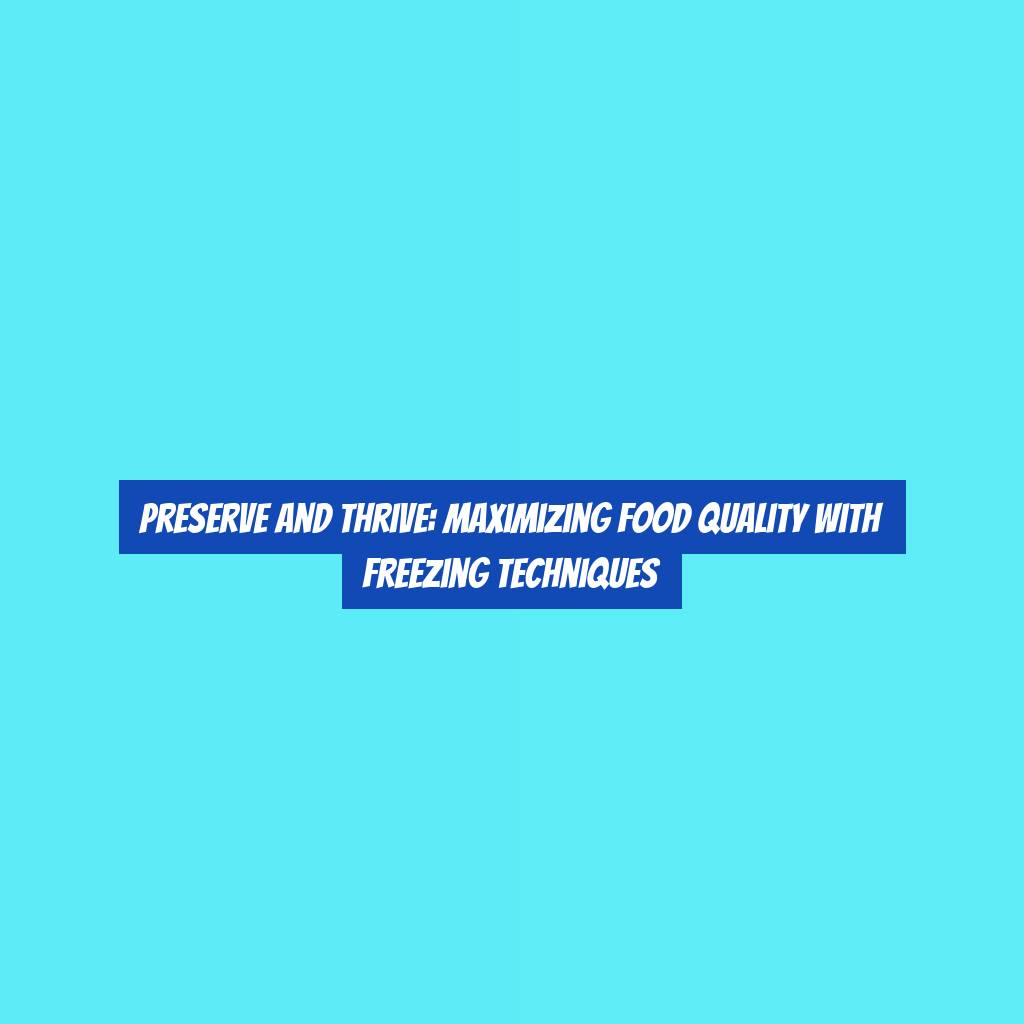Preserve and Thrive: Maximizing Food Quality with Freezing Techniques
Did you know that freezing food can help it retain up to 90% of its original nutrients? Understanding the proper techniques for freezing food can not only help you preserve the quality of your food, but also maximize its nutritional value.
By implementing the right freezing methods and storage techniques, you can ensure that your frozen foods maintain their flavor, texture, and nutritional content.
Whether youG??re a home cook looking to reduce food waste or a food business aiming to deliver high-quality products, mastering the art of freezing can significantly impact the quality of your food.
Understanding Freezing Basics
If you want to preserve food using freezing techniques, itG??s essential to understand the basics of how freezing works and its impact on food quality.
Freezing slows down the growth of microorganisms, enzymes, and chemical reactions that can cause food spoilage. When food is frozen, the water inside it forms ice crystals, which expand and can break down the cell walls of the food. This can lead to changes in texture and moisture content when the food is thawed.
To minimize these changes, itG??s crucial to freeze food as quickly as possible to create smaller ice crystals, which cause less damage to the foodG??s structure.
Additionally, packaging plays a vital role in preserving the quality of frozen food. Proper packaging helps prevent moisture loss, freezer burn, and the absorption of odors. ItG??s important to use packaging materials specifically designed for freezing, such as airtight containers or freezer bags, to maintain the best possible quality.
Choosing the Right Packaging
To ensure the preservation of food quality, choosing the right packaging for freezing is essential as it helps prevent moisture loss, freezer burn, and the absorption of odors. When selecting packaging for freezing, opt for materials specifically designed for this purpose, such as heavy-duty plastic bags, vacuum-sealed pouches, or airtight containers.
These options create a protective barrier against air and moisture, safeguarding the texture and flavor of the food. Ensure that the packaging is durable and can withstand freezing temperatures without becoming brittle or cracking. Additionally, consider the size of the packaging to match the portion of food being frozen, as this minimizes air exposure when the package is opened for use.
Labeling the packaging with the contents and freezing date is also crucial for easy identification and to track the freshness of the food. By choosing the right packaging for freezing, you can maintain the quality of your food, preserve its nutrients, and enjoy delicious meals even after extended periods in the freezer.
Proper Freezing Methods
Consider using a freezer with a consistently maintained temperature for optimal freezing results. Ensure that the freezer maintains a temperature of 0-?F (-18-?C) or lower to preserve the quality of the food.
When freezing food, itG??s essential to cool it down as quickly as possible to minimize the formation of large ice crystals, which can affect the texture and flavor. Spread the food out in a thin, even layer on a baking sheet before placing it in the freezer. Once the food is frozen solid, transfer it to airtight, freezer-safe containers or bags to prevent freezer burn. Label the containers with the date and contents for easy identification.
For best results, avoid overloading the freezer at once, as this can raise the temperature and slow down the freezing process. Instead, freeze smaller quantities of food at a time. Additionally, make sure to leave enough space between the containers for air to circulate, allowing for even freezing.
Maximizing Freezer Space
To make the most of your freezer space while maintaining optimal freezing results, itG??s important to consider strategic organization and storage techniques. Here are some tips to help you maximize your freezer space:
-
Use stackable containers: Utilize stackable containers to make the most of vertical space. This will help you fit more items in your freezer without sacrificing organization.
-
Invest in vacuum-sealed bags: Vacuum-sealed bags not only help to preserve the quality of your food but also take up less space compared to traditional storage methods.
-
Group similar items together: Organize your freezer by grouping similar items together. This will make it easier to locate specific items and maximize space by avoiding unnecessary clutter.
-
Consider shelf and drawer organizers: Utilize shelf and drawer organizers to create designated spaces for different types of food. This will help prevent items from getting lost in the depths of the freezer and make the most of available space.
Optimizing Food Quality
One effective way to optimize the quality of frozen food is by properly prepping and packaging it before storage. Start by selecting only the freshest produce, meats, or prepared dishes for freezing. For fruits and vegetables, blanching before freezing can help maintain their color, texture, and nutritional value. When packaging, use high-quality freezer-safe containers or heavy-duty freezer bags to prevent freezer burn and maintain freshness. Ensure all excess air is removed from the packaging to minimize the risk of ice crystals forming, which can degrade food quality over time.
ItG??s important to label all items with the freezing date and use a G??first in, first outG?? system to ensure youG??re consuming the oldest items first. Additionally, freezing food at its peak ripeness or freshness will help lock in the best flavor and nutrient content. When defrosting, do so in the refrigerator to maintain food safety and quality.
Conclusion
So, remember to always use proper freezing methods and the right packaging to preserve and maximize the quality of your food.
By optimizing freezer space and understanding the basics of freezing, you can ensure that your food stays fresh and delicious for a longer period of time.
With these techniques, you can enjoy high-quality meals and ingredients all year round.
